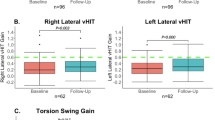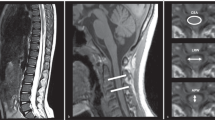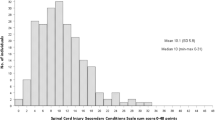Abstract
Study design:
The excitability of the vestibular apparatus and pathways was studied in 10 patients with acute spinal cord injury (ASCI) and in 7 patients with chronic spinal cord injury (CHSCI).
Objectives:
Proprioceptive input that may be lost after spinal cord injury (SCI) is needed for integration with vestibular signals to produce proper postural control and perception of movement. This study examined whether there is a change in vestibular excitability after the disruption of the afferent proprioceptive input due to the spinal cord lesion. This study was carried out at Spine Injury Centre and Institute of Rehabilitation, Belgrade, Serbia.
Methods:
A total of 10 patients with ASCI and 7 with CHSCI were compared to a group of 50 age-matched healthy subjects. The excitability of the vestibular pathways was studied by means of a modified caloric test in which the duration of postcaloric nystagmus was measured.
Results:
ASCI patients with cervical lesions showed significantly reduced response durations (P<0.05). There was no difference in control values for ASCI and for CHSCI patients with thoracic or lumbal lesions. There was no difference in control values for cervical CHSCI patients.
Conclusions:
These results suggest that the vestibular response to caloric stimulation is supported by spinally mediated sensory input and that the loss of such input is compensated for over time. Further, these results show that the caloric test may be a useful tool for assessing the degree to which SCI disrupts multisensory integration in the vestibular system and tracking the process of reintegration.
Similar content being viewed by others
Log in or create a free account to read this content
Gain free access to this article, as well as selected content from this journal and more on nature.com
or
References
Leigh RJ . What is the vestibuloocular reflex and why do we need it?. In: Baloh RW, Halmagyi GM (eds). Disorders of the Vestibular System. Oxford University Press: New York, 1996, pp 12–19.
Fetter M, Dichgans J . How do the vestibule-spinal reflexes work?. In: Baloh RW, Halmagyi GM (eds). Disorders of the Vestibular System. Oxford University Press: New York, 1996, pp 105–114.
Mergner T, Hlavacka F, Schweigert G . Interaction of vestibular and proprioceptive inputs. J Vestib Res 1993; 3: 41–57.
Horak FB, Shupert CL, Dietz V, Horstmann G . Vestibular and somatosensory contributions to responses to head and body displacements in stance. Exp Brain Res 1994; 100: 93–106.
Allum JH, Honegger F, Acuna H . Differential control of leg and trunk muscle activity by vestibule–spinal and proprioceptive signals during human balance corrections. Acta Otolaryngol 1995; 115: 124–129.
Wilson VJ, Yamagata Y, Yates BJ, Schor RH, Nonaka S . Response of vestibular neurons to head rotations in vertical planes. III. Responses of vestibulocollic neurons to vestibular and neck stimulation. J Neurophysiol 1990; 64: 1695–1703.
Zarzecki P, Blum PS, Bakker DA, Herman D . Convergence of sensory inputs upon projection neurons of somatosensory cortex: vestibular, neck, head and forelimb inputs. Exp Brain Res 1983; 50: 408–414.
Allen GI, Sabah NH, Toyama K . Synaptic actions of peripheral nerve impulses upon Deiter's neurons via the climbing fibre afferents. J Physiol (London) 1972; 266: 311–333.
Gdowski GT, McCrea RA . Integration of vestibular and head movement signals in the vestibular nuclei during whole-body rotation. J Neurophysiol 1999; 82: 436–449.
Iles JF, Pisini JV . Vestibular-evoked postural reactions in man and modulation of transmission in spinal reflex pathways. J Physiol 1992; 455: 407–424.
Britton TC, Day BL, Brown P, Rotthwell JC, Thompson PD, Marsden CD . Postural electromyographic responses in the arm and leg following galvanic vestibular stimulation in man. Exp Brain Res 1993; 94: 143–151.
Marino RJ, Barros T, Biering-Sorensen F, Burns SP, Donovan WH, Graves DE et al. ASIA Neurological Standards Committee. International standards for neurological classification of spinal cord injury. J Spinal Cord Med 2003; 26 (Suppl 1): S50–S56.
Strupp M, Brandt T . Pharmacological advances in the treatment of neuro-otological and eye movement disorders. Curr Opi Neurol 2006; 19: 33–40.
Kumar A, Sutton DL . Diagnostic value of vestibular function tests: an analysis of 20 consecutive cases. Laryngoscope 1984; 94: 1435–1441.
Vibert D, Haeusler R . Acute peripheral vestibular deficits after whiplash injuries. Ann Otol Rhinol Laryngol 2003; 112: 246–251.
Boyl R, Highstein SM . Efferent vestibular system in the toadfish: action upon horizontal semicircular canal afferents. J Neurosci 1990; 10: 1570–1582.
Kelders WP, Kleinrensink GJ, van der Geest JN, Feenstra L, de Zeeuw CI, Frens MA . Compensatory increase of the cervico-ocular reflex with age in healthy humans. J Physiol 2003; 15: 311–317.
Chester AR, Kevin DM . The vestibulosympathetic reflex in humans: neural interactions between cardiovascular reflexes. Clin Exp Pharmacol Physiol 2002; 29: 98–102.
Kalkulas BA . A review of the neuropathology of human spinal cord injury with emphasis on special features. J Spinal Cord Med 1999; 22: 19–24.
McKay WB, Lim HK, Priebe MM, Stokic DS, Sherwood AM . Clinical neurophysiological assessment of residual motor control in post-spinal cord injury paralysis. Neurorehabil Neural Repair 2004; 18: 144–153.
Finnerup NB, Gyldensted C, Fuglsang-Frederiksen A, Bach FW, Jensen TS . Sensory perception in complete spinal cord injury. Acta Neurol Scand 2004; 109: 194–199.
Curthoys IS, Halmagyi GM . How does the brain compensate for vestibular lesions? In: Baloh RW, Halmagyi GM (eds). Disorders of the Vestibular System. Oxford University Press: New York, 1996, pp 145–151.
Acknowledgements
This work was inspired by professor Milan R Dimitrijevic's work with spinal cord injury patients. We thank engineer Ljubomir Damjanovic, biologist Zoran Gacic and neurophysiologist Barry McKay for reviewing the paper as well as for technical help.
Author information
Authors and Affiliations
Corresponding author
Rights and permissions
About this article
Cite this article
Ribarić-Jankes, K., Čobeljić, R., Svetel, M. et al. Vestibular function after spinal cord injury: preliminary results. Spinal Cord 47, 401–404 (2009). https://doi.org/10.1038/sc.2008.163
Received:
Revised:
Accepted:
Published:
Issue date:
DOI: https://doi.org/10.1038/sc.2008.163



